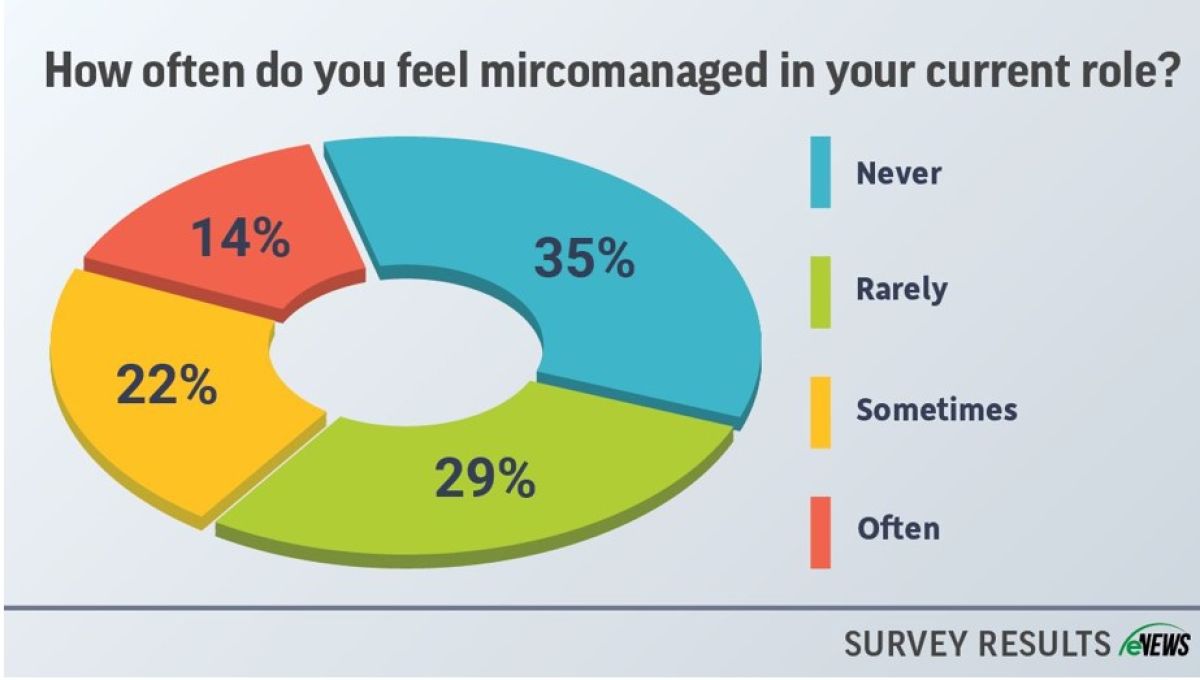eNews, Leadership
Micromanagement: Hidden costs and solutions

Micromanagement is often seen as a method for maintaining control and ensuring high standards, but its hidden costs can be detrimental to both employees and organizations. The financial impact can also be significant, with decreased productivity, higher turnover rates and a toxic work environment that discourages growth.
Why it matters: Understanding the impacts of micromanagement and exploring alternative management strategies is key to building a more effective and empowered workforce.
Micromanagement is defined as a management style where a manager closely monitors and controls their employees and their work. It involves constantly asking for updates, difficulty delegating tasks and providing excessive feedback and corrections.
By the numbers: A recent eNews poll found that 14% of credit professionals often feel micromanaged in their roles. In contrast, 35% never feel micromanaged.
While it aims to ensure high standards and prevent errors, micromanagement often reduces employee morale, stifles creativity and erodes trust. “The constant oversight and control can create a hostile work environment, where employees feel suffocated and restricted in their actions,” said Alaina Worden, CCE, credit and collections manager at CECO, Inc. (Portland, OR).
Micromanagement can also slow down workflow and productivity of a team. According to a Trinity Solutions survey, 71% of professionals said micromanagement interfered with their job performance.
- 85% reported their morale was negatively impacted
- 69% considered changing jobs due to micromanagement
- 36% changed jobs
“In a previous role, I thought it would be better if my manager took over the project,” Worden said. “Although it was finished on time, it took far more hours than necessary.”
Excessive micromanagement can make team members feel undervalued and demotivated. “Being micromanaged to me is someone who does not let you grow,” said Stacey Jones, account representative at NACM South Atlantic (Alvarado, TX). “It just puts more pressure on you and doesn’t give you room to work independently.”
Yes, but: The concept of micromanaging is subjective, and many people do not recognize when they are being micromanaged or are micromanaging others. “In a previous role, I’d never be able to complete projects on time because my manager kept rewriting my edits,” Worden said. “At the time, I felt as though I wasn’t skilled enough, but looking back, I believe it was a case of micromanagement.”
Why do leaders micromanage?
Leaders may feel the need to micromanage others based on their personality. For example, an intense need to control or a fear of failure may cause leaders to be involved in every aspect of their team’s work. Or past experiences may have led them to micromanage employees to ensure accuracy and efficiency.
Sometimes, employees are more prone to being micromanaged based on their performance. For example, newer employees or employees who are struggling may require extra training or closer monitoring of their work to improve.
The prevalence of micromanagement can also depend on your company. For instance, small teams lend themselves to management opportunities while hybrid or remote work environments can lead to increased micromanagement due to reduced in person interaction.
Some tasks need more micromanagement due to their complexity or error risk. For example, creating a reference for a customer requires accurate documentation and strong oversight to mitigate risk.
Tips to avoid micromanaging
#1 Trust your team
Being open and candid with your team on responsibilities, timelines and expectations is pivotal in avoiding micromanaging. “With clear goals and trust, you can create a positive work environment that fosters success,” Worden said. “By doing so, you’re empowering team members to take ownership of their work and thrive without the need for constant oversight and control.”
#2 Focus on the lesson, not the mistake
It’s how you respond when you or your employees make mistakes that matters. Taking the time to talk about the problem will help you find solutions and prevent future mistakes. “Having someone discuss the situation with you, give you grace and treat you as an equal to me is the lesson that helps you grow and further yourself in your career,” Jones said.
#3 Communicate
To avoid micromanaging, communicate to your team the desired outcomes, deadlines and criteria for success. Communicating consistently with your team will not only improve workflow but will build a foundation of trust for the future. “I have weekly one-hour team meetings and individual touch-base meetings with each of my direct reports to strengthen that communication,” said Holly McAndrew, senior credit manager global wholesale at Urban Outfitters, Inc. (Philadelphia, PA). “I believe that everyone needs to be given the latitude to have their voice heard while managing their workload on their own terms.”
Also, communicate with other departments you work closely with, such as sales or procurement, to keep everyone informed and minimize errors in the long-run.
#4 Know your employees
Knowing your employees on a deeper level will help you manage them more efficiently. For instance, you can match tasks to your team members’ skills, interests and developmental needs. “It’s critical that you work with a level of transparency so that they can develop their own working style and work independently,” McAndrew said.
The bottom line: To build a more effective and empowered workforce, it’s important to understand the impacts of micromanagement and explore alternative management strategies.





